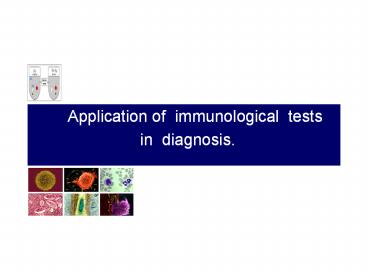Application of immunological tests - PowerPoint PPT Presentation
Title:
Application of immunological tests
Description:
Types of serological Tests ... Times New Roman Arial Default Design Slide 1 Antigen -Antibody Reactions . Types of serological Tests Agglutination Test ... – PowerPoint PPT presentation
Number of Views:191
Avg rating:3.0/5.0
Title: Application of immunological tests
1
- Application of immunological tests
- in diagnosis.
2
Antigen -Antibody Reactions .
- Antigen antibody reactions are performed
to determine the presence of either the
antigen or antibody. ( serological tests ). - One of the two components has to be
known. - e.g. with a known antigen, such as
influenza virus , a test can determine
whether antibody to the virus is present
or not .
3
Types of serological Tests
- Agglutination
- In this test the antigen is particulate (e.g.
bacteria and red blood cells) or an inert
particle (latex beads) coated with antigen. - Antibody is divalent and cross links the
multivalent antigen to form a lattice
network or clumps
(agglutination). - This reaction can be performed in a tube
or on a glass slide e.g. ABO blood
grouping.
4
Agglutination Test positive.
negative.
Antibody.
antigen
5
Antigen Antibody Reactions
- Haemaggultination Tests
- Viruses can clump red blood cells from one
species or another (active hemagglutination)
. - This can be inhibited by specific anti-viral
antibodies. - Red cells can also absorb many antigens and when
mixed with specific antibodies will form
clumps (passive hemagglutination) i.e. red
cells are passive carriers .
6
Haemaggultination Tests
7
Precipitation test
- In this test antigen is in soluble form
(solution). - Antibody cross -links antigen molecules to
form aggregates (precipitates) in the
zone of equivalence optimal proportion of
antigen and antibody. - Precipitation test can be performed in
solution or in semi- solid medium (agar).
8
Zone of Equivalence
9
Precipitation in Agar.
- Single radial immunodiffusion
- Antibody is incorporated into agar and
antigen introduced into the well. - As antigen diffuses into agar precipitation
rings form depending on the concentration
of the antigen. - Radial Immunodiffusion is used to measure
IgG, IgM and complement components.
10
Single Radial Immunodiffusion.
11
Double immunodiffusion.
- Antigen and antibody are placed in different
wells in agar and allowed to
diffuse and form precipitation lines at
the points of optimal concentrations. - This method is used to determine whether
antigens are related, identical or
non identical.
12
Precipitation Test
13
Double immunodiffusion
14
RAST
Radioimmunoassay ( RAST) measure specific IgE.
15
Enzyme Linked Immunosorbent Assay (ELISA)
- This method is used for measuring either
antigen or antibody in patient serum .. - For measurement of antibody, known antigen is
fixed to a surface i.e. bottom of small wells on
a plastic plate. - Incubated with dilutions of the patients
serum. - Washed and then re-incubated with anti-human
antibody labeled with an enzyme i.e.
horseradish peroxidase.
16
ELISA .
antigen
Antibody.
Enzyme Labelled antibody
Enzyme substrate.
17
ELISA .
- Enzyme activity is measured by adding the
substrate for the enzyme that leads
to development of a color. - Color reaction is estimated in a
spectrophotometer. - The amount of antibody bound is
proportional to the enzyme activity. - The titer of antibody in patients serum is
the highest dilution of the serum
that gives a positive color reaction .
18
ELISA
Intensity of color correspond to concentration of
antibody.
19
Immunofluoresence
- Fluorescent dyes e.g. fluorescein and
rhodamine can be covalently attached to
antibody molecules and made visible by
ultraviolet (UV) light in a
fluorescent microscope. - Such labeled antibody can be used to
identify antigens on surface of
microorganisms ( e.g. treponemes), in
histological section or in other
specimens.
20
Immunofluoresence
- Immunofluoresence reaction is called direct when
a known labeled antibody interacts
directly with unknown antigen . - Indirect Immunofluoresence involves a two
stage process - Patients serum is added, incubated and the
preparation is washed. - Antigen is attached to a slide.
- Antibody of interest if present will
remain attached and can be detected by
addition of fluorescent dye labeled
antibody under UV light.
21
Immunofluoresence .
Antigen fixed on slide e.g. nuclear antigen .
Biopsy specimen from patient.
22
Antigen Antibody Reactions
Immunofluoresence .
23
Antigen Antibody Reactions
- Complement Fixation
- Based on the principle that antigen and
antibody reaction activates complement . - Antigen and antibody, one known and the other
unknown are mixed. - A measured amount of complement is added .
- If antigen-antibody reaction has occurred it
will combine fix complement.
24
Complement Fixation
- An indicator system consisting of sensitized
red blood cells (red blood cells plus anti-red
blood cell antibody) is added. - If the complement was fixed because of antigen
antibody reaction red cells will not be
hemolyzed i.e. the test is positive. - If the antigen antibody reaction did not occur in
the first step complement will not be fixed and
will be available to lyse RBCs a negative
test.
25
Complement Fixation Test
26
Diagnosis of cell-mediated responses
- 1. Delayed hypersensitivity reactions .
- - delayed skin test.
- - patch test.
- 2. Lymphocyte transformation test .
- lymphocyte activation test.
- ( detect markers by flow cytometry .)
27
contact dermatitis diagnosed by patch test .
28
Patch test for contact dermatitis .
29
Type 1 allergy diagnosed by skin prick test .































